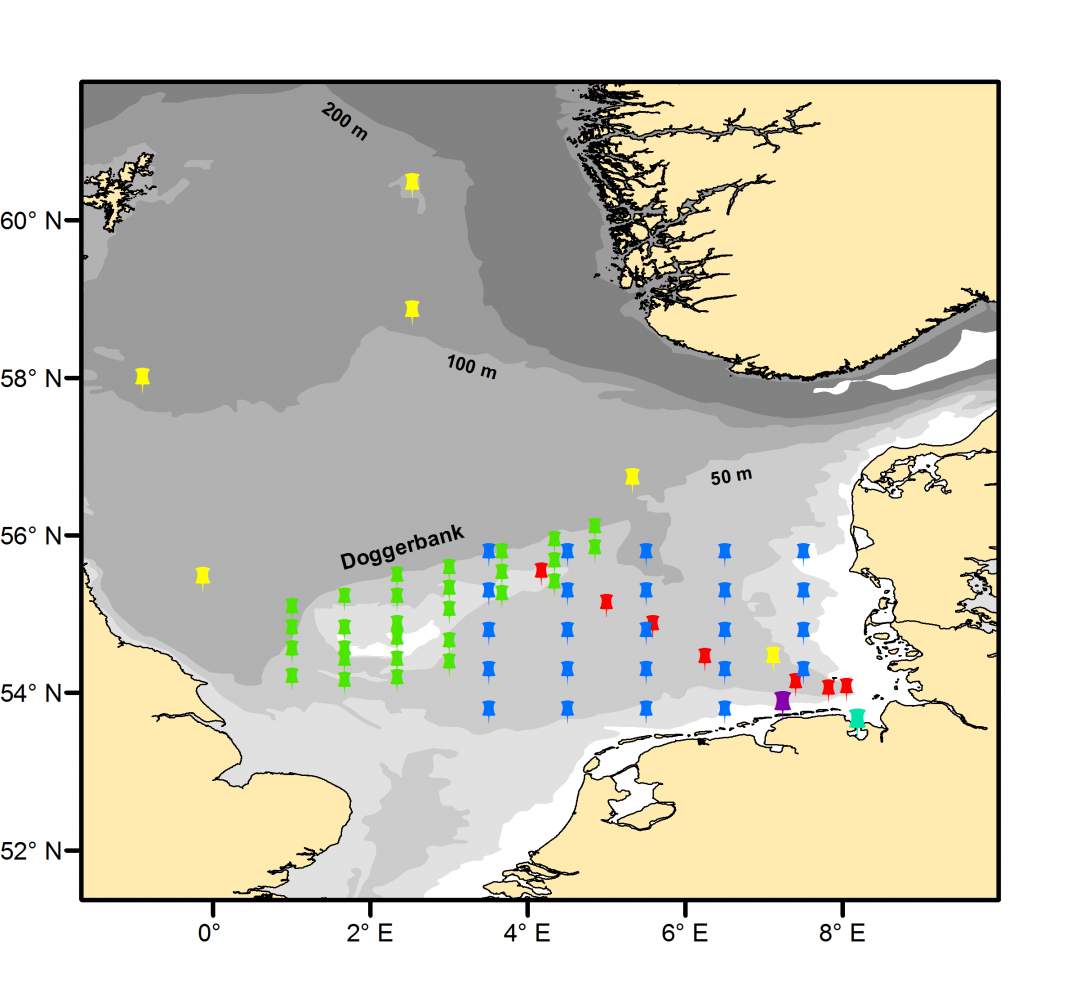
What is Benthos?
The Benthos includes the organisms and communities living in and at surface of the sea floor, which are dominated by invertebrates. These organisms are a major food source for fish and ply a major role in remineralisation and flux of organic matter deposited in the sea floor. Benthic ecology is the major topic of the Marine Biology Section.
The major part of the benthic fauna is burried in the sediments and is, thus, called “Infauna”. Endofauna

Profile of the sea floor showing typical infaunal organisms (from Tardent). a) Barnacles (Balaniden), b) Blue mussels (Mytilus edulis), c) Polychaete Lanice conchilega, d) Polychaete Lagis koreni, e) Snail Littorina littorea, f) Rasor clam (Ensis americanus), g) Bivalve Cerastoderma edule, h) Bivalve Scrobicularia plana, i) Bivalve Mya arenaria, k) Polychaet Arenicola marina, l) Polychaete Hediste diversicolor, m) Bivalve Macoma balthica.
The infauna is divided into three different size classes: Macro- and Meiofauna and Microorganisms.
The macrofauna (>0,5 mm) includes polychaetes (Polychaeta), bivalves (Bivalvia), snails (Gastropoda), amphipods (Amphipoda) and echinoderms (Echinodermata).
Extremely small organisms (>63<500 µm) belong to the meiofauna. This interstitial fauna prefers sandy sediments.
Microorganims are protists and bacteria.
The epi- or megafauna (>1 cm) lives at the surface of the sea floor, the organisms are bigger and mobile such as sea stars, swimming crabs and anthozoans.
The sampling of the infauna is carried out with grabs and corer (z. B. Van Veen Grab, Box corer), which are lowered from the research vessel to the sea floor. The standardised grabs provide quantitative data.
Epifauna is sampled with dredges or a 2 m beam trawl. These gears are towed behind the ship. The mesh size of the cod end of the net determines the size of the fauna caught.
Because of their sessile habit, benthic organisms and communities are supposed to be good indicators for marine environmental change. Due to strong natural variability of benthic communities, long-term studies or monitoring is essentiell to detect real long-term trends. Long-term studies are part of our work since 1970s.
Senckenberg benthic long-term studies = LTER North Sea Benthos Observatory
- Epifauna Jade since 1972 in the 2nd and 3rd quarters with FK “Senckenberg”
- Infauna off Norderney since 1978 in the 1st, 2nd and 3rd quarters with FK “Senckenberg”
- Infauna Transect from German Bight to Dogger Bank since 1990 in May with FK “Senckenberg”
- In- and Epifauna in 6 Boxes from German Bigth to northern North Sea since 1998 in July/August with FFS “Walther Herwig III”
- In- and Epifauna south-eastern North Sea since 1998 in July/August with FFS “Walther Herwig III”
- Infauna Dogger Bank, per Decade, 1920s, 1950s, 1980s, 1990s, 2000s with FK “Senckenberg”
- Infauna Jade Bay, per Decade, 1930s, 1970s, 2009 with FK “Senckenberg”

Long-term studies carried out in the North Sea revealed that benthic communities in the entire southern North Sea (südlich 58° N) have changed. A 1.5 to 4 fold increase in biomass was found since the 1970 as well as a drecrease in long-living species and an increase in small short-living “opportunistic” species.
Eutrophication and intensive beam trawl fishery are found to be the major reasons for the changes in the benthic system. Beside these anthropogenic impacts climate change affects the North Sea benthos as shown by our studies off the island of Norderney and at the Dogger Bank.
The studies sites reach from coastal regions such as the East-Frisian Wadden Sea and the Jade Bay towards the open North Sea(German Bight, Dogger Bank, Skagerrak and Kattegatt) to deep-sea areas (Arctic Ocean, Mediterranean Sea, South Atlantic).
Main topics in benthic ecology are:
- In- and epifaunal biodiversity patterns on different temporal and spatial scales
- Long-term studies on the variability of species number, abundance and biomass of in- and epifauna
- The role of environmental factors and food availability for the structure and functionial diversity of benthic communities
- Relationship between different benthic size classes
- Benthic food webs
- Benthic species distribution modelling
- Use of hydroacoustic advices for large-scale benthic habitat mapping
- Anthropogenic effects on benthic communities